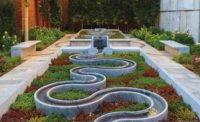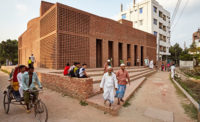The new Aga Khan Garden, near Edmonton, in the Canadian province of Alberta, is the largest garden in North America to interpret the landscape traditions of Islam. At a latitude above 53 degrees, it is also the world’s northernmost, translating the desert-based horticultural traditions of Islam for Alberta’s short summers and cold winters.
Additional Content:
Jump to credits & specifications
For centuries, gardens have symbolized a spiritual ideal in Muslim culture. They are places “where the human meets further proof of the divine,” the Aga Khan, spiritual leader of the Shia Ismaili Muslims, has said in speeches on the subject, “and where the ingenuity of humanity and the beauty of nature are productively connected.” Sponsored by the Aga Khan Trust for Culture, the 12-acre project within the University of Alberta Botanic Garden (UABG) is intended to foster intercultural dialogue and understanding.
“It was a tall order to imagine what a garden inspired by Islamic landscapes would look like in Alberta in the 21st century,” says Breck Gastinger, a senior associate at Nelson Byrd Woltz (NBW), the project’s New York– and Charlottesville, Virginia-based landscape architect. In a remarkable fusion, the design uses the formal structure of the Islamic garden as a frame for the Canadian parkland biome’s dramatic seasonal shifts. Drawing on the landscape firm’s award-winning research into historic precedents, the $19 million project comprises forest walks, a central court of granite and limestone terraces, a dozen pools and fountains that express the manifold nature of water, and an informal orchard of locally adapted trees, all linked by views across a naturalis tic wetland.
From the garden’s entry court, a woodland walkway makes a quiet beginning, passing a lozenge-shaped black granite pool that reflects the sky, and stands of wild roses, Alberta’s emblematic flower, that bloom among the trees. Emerging from the forest, the path climbs to a shaded terrace, or talar, that overlooks a four-part court, or chahar bagh, together forming the most structured and identifiably Islamic part of the garden. A limestone colonnade the length of the talar supports a series of orange tensile canopies, whose vibrant glow contrasts with the forest backdrop.
Water, precious in desert cultures (and increasingly so elsewhere), wells up out of a massive block of polished granite on the talar, seemingly the source for a waterfall and rippled chute that flow to the channels of the chahar bagh. In addition to the plays of texture, illumination, and pattern that celebrate water, the garden’s formal geometry seamlessly integrates a series of stepped and calibrated beds for wetland plant nurseries, seed production, and botanic research. Beyond, a restored wetland surrounded by fruit trees expresses the theme of stewardship.
At opposite corners of the chahar bagh—where the formal garden opens to paths encircling the pond—a rose garden and an “ice garden” symbolize the Alberta setting. The rose garden centers on a five-petaled fountain, with a paving pattern based on the rose’s fivefold symmetry. The ice garden’s paving pattern is based on sixfold symmetry, the structure of ice crystals and snowflakes, and includes openings for fog jets to mist the small space on summer days.
Throughout the garden, the use of precise geometry at multiple scales, from layout to detailing, refers to the mathematical order underlying nature. “Geometry is scaleless, both infinitely small and infinitely large,” says Gastinger, “so tapping into it offers a pathway to greater understanding of the natural world.” The design team wanted the garden’s Islamic sources to be legible, he says, “but we definitely wanted to avoid falling into the trap of pastiche.” Photography highlighting the project’s geometric motifs may give the impression that it teeters on the edge of that trap, but in person the experience of scale within the garden’s expanse creates a much more subtle effect.
The exception, arguably, is a series of decorative panels that form the court’s guardrails. A riff on jali window screens, which traditionally are carved from stone, the panels are executed in ultra-high-performance concrete. Seen in a desert or urban garden, their ornate tracery would have supplied a welcome layer of texture, play of light, intimacy of scale, and permeability to spaces beyond. Here, however, the filigreed curtain of woodland that surrounds the garden suggests a missed opportunity: a simpler, more contemporary panel design would have let the natural intricacy of the parkland forest shine.
Swaths of flowering annuals, climate-adapted perennials, and pollinator-friendly plants fill sunken gardens edging the chahar bagh’s quadrants. Historically, sunken gardens brought the scent and fruit of citrus trees to the visitor’s level, but here they set the flowers at a greater remove. At first this seems a puzzling choice—until you remember the garden’s primary goal is to create a public space for dialogue and understanding. The sunken beds support this goal by seeming to elevate the shared domain and make it more open.
The result is an elegant public forum where one can imagine—as the garden’s sponsor, host institution, and designers hoped—that local and global communities will gather in the presence of nature to advance their mutual understanding. In the Koran, the garden is a metaphor for paradise.
Credits
Architect: DIALOG
Landscape architect of record: Nelson Byrd Woltz Landscape Architects — Thomas Woltz, Breck Gastinger, Nathan Foley, Sandra Nam Cioffi, Jen Trompetter, Alisha Savage, Siobhan Brooks, Fraser Stuart, Kari Roynesdal, Mandi Fung
Engineering: DIALOG
General contractor: Clark Builders
Size: 435,600 gross square feet
Construction cost: $19 million
Completion date: October 2018 |
SpecificationsSystems Rain Bird, ACO Drain, Zurn
Hardscape Expocrete, Owen Sound Ledgerock, A. Lacroix Granit, Permaloc
Lighting BEGA, WAC Lighting |













Post a comment to this article
Report Abusive Comment